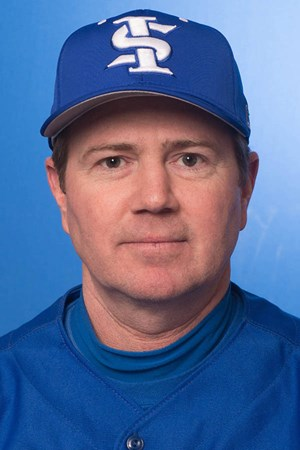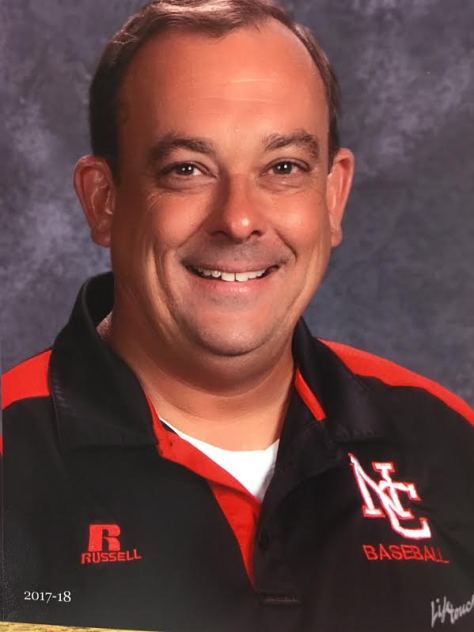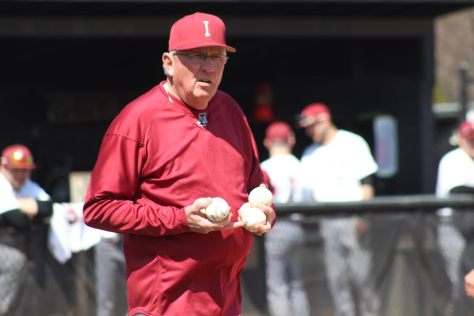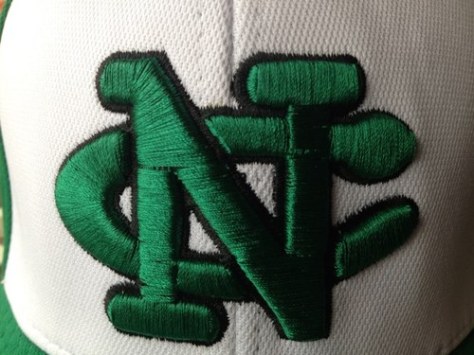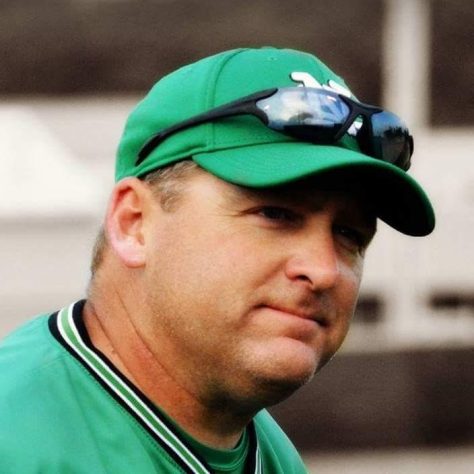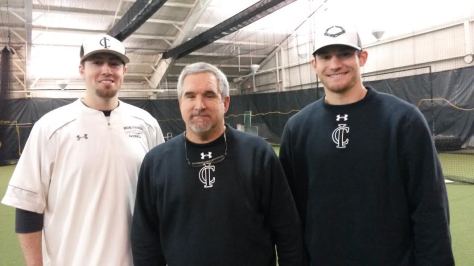
By STEVE KRAH
Navigating the maze that can be college baseball recruiting, players and their parents can use some straight-forward answers.
Jeremy Sheetinger, a former college player and coach who is now College Division Liaison for the American Baseball Coaches Association and ABCA “Calls from the Clubhouse” Podcast host, travels the country to offer advice.
That’s just what he did recently in a visit to the South Bend Cubs/1st Source Bank Performance Center as guest of director Mark Haley and Indiana University South Bend head coach Doug Buysse.
Sheetinger, who played at Franklin County (Ky.) High School and Kentucky Wesleyan College (NCAA Division II) and was an assistant and recruiting coordinator at both Brescia University (NAIA) and assistant at Georgetown College (NAIA), Director of Operations at the University of Kentucky (D-I), lead assistant and recruiting coordinator at Saint Joseph’s College (D-II) in Indiana and head coach at Spalding University (D-III) in Louisville, packed in plenty of information.
The high-energy Sheetinger, who now lives in Greensboro, N.C., where the ABCA is headquartered, and also serves as a associate scout with the Atlanta Braves, covered coach evaluations, parents’ impact and role, contact with coaches, campus visits, resources, differences in collegiate levels, finding the right fit, making a recruiting video, camps and showcases and a timeline for freshmen, sophomores, juniors and seniors.
EVALUATION
Sheetinger, who has given talks on recruiting about 2,000 times and worked baseball camps in 35 different states, says coaches are always evaluating and projecting players.
They use their past experiences and players to judge current players.
“We’ve got to use what we know to be true,” says Sheetinger. “If I see a kid who’s 6-2, 180 with a clean right-handed swing, I will remember a player who went on to be a conference player of the year. If I see 5-7, 135 with a bad swing (and short parents), I know that kid is never going to be 6-2.
“I’m looking at you through the eyes of all the players I ever coached. Mom and dad, it has nothing to do with your opinion of him as a player.”
If catchers take too long to get rid of the baseball with a very slow POP time, but can mash at the plate, they might help a college team as a first baseman.
A player with strong, accurate arm who can run might be a fit in a college outfield. But that throw must be on the money.
“When it’s time to throw something out, you’ve got to throw somebody out,” says “Coach Sheets.”
It’s also possible that movement that hurts a player in the outfielder helps him as a pitcher.
What about that big-bodied kid at shortstop for his high school?
“He can’t play short in college, but he’s got a great arm,” says Sheetinger. “Where can he play for me? Third base.”
The five baseball tools are hit for power, hit for average, defense, arm strength and running speed.
The average high school player has an exit ball velocity of 75 to 84 mph, average arm velo of 70 to 80 mph in the field, 70 to 75 mph at catcher and a 60-yard dash time of 7.0 to 7.2 seconds.
“I’m not telling your how to spend your money,” says Sheetinger. “Hitting lessons are great. Pitching lessons are great. But think about speed lessons and conditioning lessons.
“Think about going to the track at 6 o’clock in the morning and running sprints. You go, Sheets, what are you talking about? I’m not going to the track at 6 a.m. That’s why you run a 7.9. I’ll be your best friend if you just let me.”
Velocity is not the ultimate indicator for pitchers. Pitch control, secondary pitches, composure and maturity, athleticism and handling the running game are more important.
For all players, there are intangibles like attitude, leadership, energy, Baseball I.Q., confidence, clutch and the will to win.
“College coaches are watching everything,” says Sheetinger. “They don’t miss a beat. When you’re in a showcase event or you’re in a game and coaches are present and you hit a ground ball back to the pitcher, I want to see your best 90 time.
“That stuff matters. Run your best time every time.”
Sheetinger says players are evaluated on how they handle adversity and points to the example of a recruiting trip he made while at Saint Joseph’s, looking to offer a 75 percent scholarship to a pitcher.
This kid had stuff. But he also had an attitude, though the man calling balls and strikes was squeezing him and did not hesitate to let everyone in the ballpark know it.
“Bad umpires are multiplying daily,” says Sheetinger. “That ain’t going away. I’m more interested in your body language and presence.”
The pitcher enjoyed two lights-out innings then ran into adversity in the third.
He plunked the first batter, uncorked a wild pitch to send the runner to second and then gave up a duck snort and a double in the gap. A mound visit from his coach was greeted by plenty of walking around, cap removal and lack of eye contact.
“We’ve got maturity issues,” says Sheetinger.
The coach returns to the dugout and it’s duck snort, double and another hit-by-pitch.
When the coach comes back out to take the pitcher out, the youngster heaves the ball toward the sky and the coach catches when it comes down. Before the pitcher crosses the foul line, he fires his glove into the dugout.
Recruiting visit over.
On another recruiting trip, Sheetinger remembers seeing the opposite kind of behavior. A strong No. 3 hitter popped up on the infield in a key situation.
With Sheetinger’s eyes following him the whole way, the player carries his helmet and bat to the dugout, does a 30-second re-set, puts down his equipment and his back on the rail cheering before the No. 4 hitters sees his first pitch.
“That’s a great teammate,” says Sheetinger. “That’s a really good kid. Two weeks later, he gets a Division I offer. He was never going to come to play for me. But I like watching kids like that.
“It doesn’t show up on paper. But things matter.”
Sheetinger says it is easy to measure things like fastball velocity and 60-yard time. But not everything fits on a spreadsheet.
“Some things you can’t coach,” says Sheetinger. “Can you really coach someone to hustle? I can probably put fear into you to hustle. But either you hustle or you don’t. It’s like either your pants are on-fire or they’re not. It’s not up to me to light your pants on-fire. It’s who you are internally.”
These kinds of players won’t get out-worked. They need to be taken seriously.
PARENTS’ IMPACT AND ROLE
Parents can either be a huge positive or negative influence on their son’s recruitment.
What parents do could be the first impression a coach gets about the player.
“Parents, as a college coach and as a scout, I don’t think you’re sweet when you yell at umpires,” says Sheetinger. “That’s the biggest turn-off for me of anything you do.
“Nobody barks at you when you flip burgers, let him do his job. If you want to be a coach so you can bark at umpires, apply for the job. If you need to do that, go to some other team’s game so we can track it back to your kid on the field.
“I assure you I’ve asked over a hundred people in the stands at a showcase ‘who’s dad is that?’
“Please change your ways. It reflects bad on your son.”
The Blame Game is not welcome.
“If you something against your high school coach, ask yourself this question: Does he really have something against my kid or is my kid just not good enough?,” says Sheetinger. “Most coaches will play the best players because most coaches like winning.”
Coaches pick up on how parents and players talk and act toward one another.
Players are expected to be in the forefront of the recruiting process.
Sheetinger encourages players to spend two hours twice a week doing online research on their college choices. If they are decided on their major, they start with that and see how many possible schools offer it. Then the look at the performance of the baseball program through archives, rosters and statistics.
“If a school has gone 10-40 10 years in a row, guess what Year 11 is going to look like?,” says Sheetinger. “If that coach has been there 10 years and they won five his first year, 10 his second, 20 his third year, 25 the next years and the last three years they’ve won the conference championship, that dude’s building something. The coach can’t hide that.
“Do your homework.”
The young athletes should be the ones communicating with coaches through minimal calls and emails.
“Players, take ownership of this process,” says Sheetinger. “I don’t want emails from mom and dad.”
CONTACT WITH COACHES
Email is the best way to reach out/introduce yourself to a college coach.
These emails should come from an appropriate address and be “meat and potatoes” — Subject … Name … Graduation Year … Position(s) … Hometown/High School … Grades … Research … Video link (include this with every correspondence).
Players should expects emails, texts and calls from coaches and be quick to respond to them.
Sheetinger advises players to treat every program as the most important one and to be respectful of the coach’s time and efforts.
Evaluation is still happening and communication is the key. Body language, eye contact, handshakes and paying attention all matter.
How do players talk?
What is important to them?
Sheetinger compares recruiting to dating.
“I like you,” says Sheetinger. “I’m going to try to convince you to like me.”
“I’m going to give you my spiel. We’re going to get to know your son because in a way because coaches step in as pseudo-stepfathers. We need to have a relationship. We need to have a bond. We’ve got to get along. (Parents) won’t be there.”
CAMPUS VISITS
This gives a player and his family a glance at the coaches, program, campus life and academics.
They will meet with the admissions and financial aid departments and get a campus tour etc.
Coaches will run the first visit.
Sheetinger says players should do 90 percent of the talking and parents 10 percent.
Players may make 10 official visits (spend the night) and unlimited unofficial visits (day visits).
On these visits, players are allowed to work out at D-II, NAIA and junior college schools but not at D-I and D-III.
There is a difference between a Baseball Visit (set up through the baseball staff) and Admissions Visit (no guarantee to see the baseball staff).
RESOURCES
College/University websites offer information on admissions and financial aid as well as biographies, archives, statistics and rosters for the baseball program.
Other helpful sites and resources: NCAA.org (rules, info), NCAA.com (stats, champions), NCAA Eligibility Center (formerly Clearinghouse; helps with collection of transcripts, core classes; D-I and D-II must register; cost is $65), NAIA.org, NAIA Eligibility Center (handles transcripts; all players must register; $75), FAFSA.gov (Due Oct. 1 of Senior Year), high school guidance counselor.
DIFFERENCE IN COLLEGIATE LEVELS
NCAA Division I (295 programs) may offer 11.7 max scholarships if fully funded (60 percent). Roster limits are 35 at the end of the fall with 27 on 25-percent scholarship.
Recruiting has ramped up for the majority of D-I teams.
NCAA Division II (254 programs) can give 9.0 max scholarships if fully funded (40 percent). There is no roster limit. That number will be set by the school, athletic department or coaches.
The top program work ahead in recruiting. Most are year-to-year.
NCAA Division III (383 programs) does not offer athletic scholarships. It is all academic- and financial-aid based. Like D-II, rosters are only limited by program choice.
Early decisions and admission dates are important. Most schools are year-to-year with their recruiting.
NAIA (187 program) may offer 12.0 max scholarships with exemptions. Again, there is no association-dictated roster limit. The majority of programs recruit year-to-year.
Lewis-Clark State College in Lewiston, Idaho, is one of the best college teams in the country regardless of level. The Warriors have won the NAIA World Series 19 times, including 2015, 2016 and 2017.
NJCAA (410 programs across 3 divisions) gives 24.0 max scholarships in D-I, 24.0 max Tuition scholarships (no room and board) in D-II and zero athletic scholarships in D-III. The association imposes no roster limits. Recruiting is year-to-year at most of these two-year institutions.
Tyler (Texas) Junior College has taken the last four straight NJCAA Division III national titles.
Sheetinger says there is great baseball at all levels. The top teams in D-II, D-III, NAIA and NJCAA can win games on the D-I level.
He sums it up by saying that at the upper levels of D-I, most programs are already 90 to 95 percent done getting commitments from current seniors (Class of 2018) with juniors (Class of 2019) 80 percent done, sophomores (Class of 2020) 60 percent complete and freshmen (Class of 2021) 30 to 40 percent already committed.
“That’s how accelerated recruiting has gotten,” says Sheetinger. “It wasn’t that way 10 years ago.
The ABCA recently conducted a recruiting summit. A panel of 16 coaches came up with a proposed recruiting calendar to calm down the early signings.
“Coaches don’t like evaluating 13-year-olds,” says Sheetinger. “It’s hard enough to project a 16-year-old. D-II, D-III, NAIA and junior college are hot on this senior class. You’ve got to keep things in perspective.
“There are a lot more opportunities out there.”
Sheetinger says the reason many people recall their college years so fondly is because they are 18 to 22 and away from their parents and figuring out what kind of man, worker, husband and father they’re going to be. They are sorting out their religious and political views.
Take 35 guys spending nine months together on busses and in dorm rooms, weight rooms, locker rooms and cafeterias while figuring this out and you see the beginnings of lifelong bonds.
“It’s the best experience of your life,” says Sheetinger. “If you can go play, you should go play.”
FINDING THE RIGHT FIT
Players must be a fit for a program, taking into consideration that coach’s style and the recruiting class.
Sheetinger likes to use the analogy of the fork with each prong being a priority in the college decision-making process. The fork could have as many as five prongs.
Prongs are sure to include academics and fit. Does a school offer the degree a player wants and how does he fit into the needs of the baseball program?
“You never go to play at a school that doesn’t offer a degree that you in your heart of hearts really want,” says Sheetinger.
Other things to consider are social atmosphere on-campus, location/geography and the cost.
A player might social butterfly and being in clubs or fraternities and going to concerts is important.
How big is the college compared to the player’s high school or hometown?
Is the school close enough for parents to regularly attend games?
How’s the weather?
If you don’t like the cold, maybe a school in upper Michigan is probably not for you.
If players have not asked their parents how much they are willing to pay out-of-pocket, they need to have that conversation.
Sheetinger says it is best to funnel down toward a players’ top choices of schools from 10 to 5 to 3.
Players should be aggressive, working toward and “yes” or “no” answer.
Can I play here or not?
Responses from coaches should be treated as hot leads. Response should be quick and player should try to get more info on the program and work toward campus visits.
MAKING A RECRUITING VIDEO
A professional video is not necessary. A good smartphone video will do the trick.
But a video is key. It gives coaches instant evaluation.
The video should be short. Position players will have five swing views from the side and five from the front or behind. Show a variety of defensive movement and throws (maximum of 8).
If a player has speed, show it with a 60-yard home-to-first video clip.
Pitching videos will show five fastballs, five curves and five change-ups from the wind-up and three each from the stretch.
Game footage must be edited.
Contact info, stats and coach’s info may be included.
CAMPS AND SHOWCASES
Players interested in a particular school are encouraged to go to their camp and be seen by their staff.
They must be mindful of database emails (every email doesn’t mean they are being recruited) and the “Cattle Calls” approach to camp population and marketing.
Campers should ask if other colleges will be attending. The price should be justified with how many possible evaluations they will receive by their attendance.
Sheetinger says it’s important to think of the coach’s perspective.
They notice players who stand out (bright cap and stirrups and name on the back of a jersey is helpful) and ones who exhibit hustle, energy, positivity and confidence.
A handshake and a thank you to every coach at the end of camp will go a long way.
TIMELINE
Freshmen are pointed toward strength and speed training, attending camps to get familiar with that environment and focusing on grades etc.
Sophomores continue with strength and speed training and camps and after the high school season begin emailing college coaches with info, videos, summer schedule etc.
Juniors have a very important year and season. They are looking to get their name out there. They do the training and camps and showcases in front of a large number of college coaches. They send emails to college coaches before the summer begins. They begin to funnel their list of schools.
Seniors have a very active year. They do all the training and attend unsigned senior events. They are aggressive with emails to coaches and ask for campus visits. In the fall, they have campus visits, submit applications and many will commit. In the spring and summer, they will make final visits and commit.
ABCA CONVENTION
The ABCA national convention is coming Jan. 4-7, 2018 to the Indiana Convention Center and JW Marriott Hotel in downtown Indianapolis. More than 6,000 coaches and 330 exhibiting companies are expected.
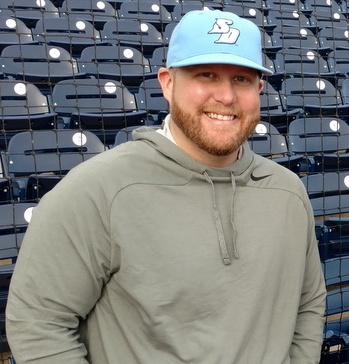
Jeremy Sheetinger is College Division Liaison for the American Baseball Coaches Association. He was in South Bend recently to advise players, parents and coaches about college recruiting. (Cornbelt Sports Photo)
